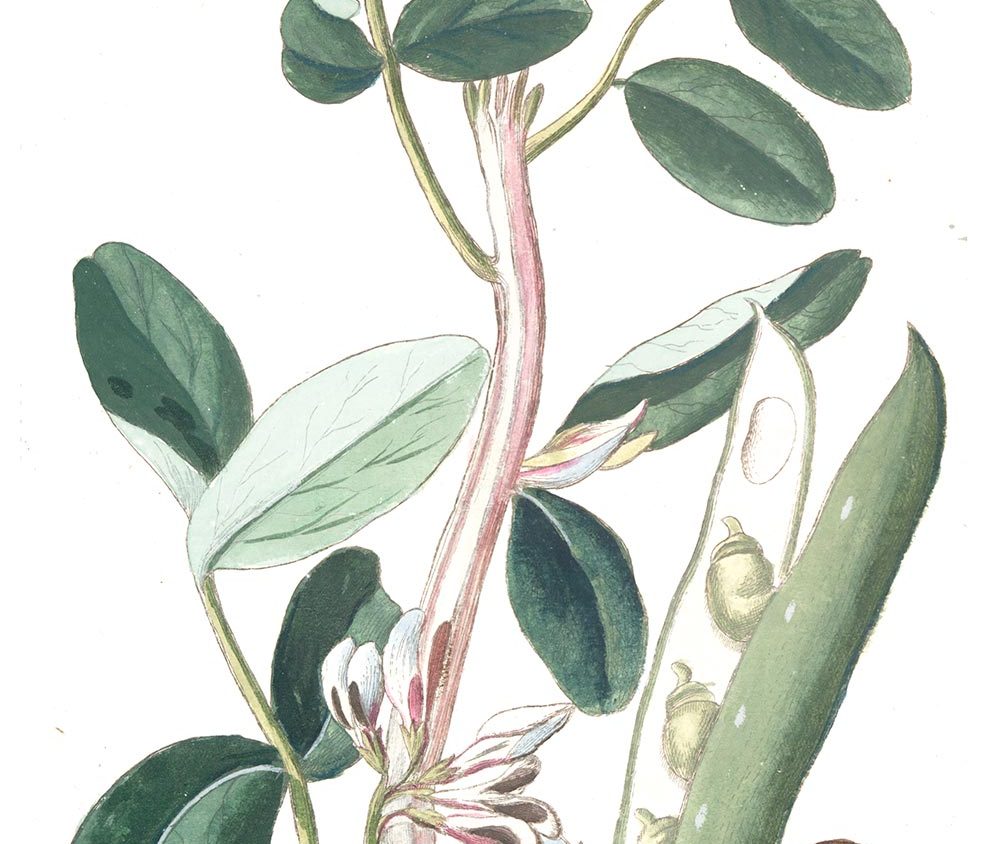Here’s why you should consider growing fava beans: They are protein-rich and tasty, and you are likely to eat more fava beans if you grow them yourself. Sown in fall, they occupy ground when space is not at a premium, and they are done in time for a planting of celery, broccoli or eggplant in early summer. Sown in early spring, they make way for a fall crop of spinach or salad greens.
Either way, the roots fix nitrogen and the tops yield a huge volume of fresh, compostable material. The plant tips make a nice tender salad green, and the pretty white flowers are edible, too!
In recent years I’ve noticed fava beans (Vicia faba) at the farmer’s market. I am happy to see them gaining in popularity. I grew up eating fava beans in Britain, where these big, flat beans are called broad beans and are eaten fresh almost exclusively.
In Middle East countries they are used as a dry bean and cooked with oil, onions and garlic to make ful medames, a classic breakfast food that’s said to be as old as the pharaohs.
For some, favas are an acquired taste. Immature pods just a few inches long can be steamed and eaten whole (a taste I never acquired myself). The beans themselves are bright green inside, with a pale, greenish white skin. When small (about a half inch long, depending on variety) the beans can be eaten with skins intact. Left to achieve their mature size, they are usually peeled after cooking.
In my childhood home they were cooked just prior to their mealy maturity and left unpeeled. The peel gives these beans a very distinctive flavor. I like it very much, but some people find it bitter. These days I usually peel my cooked beans, or mix unpeeled small beans with peeled larger ones. Whatever their state, cooking fresh favas requires only a few minutes in boiling water.
The plants are quite prolific. Last year my 10-by-4-foot patch yielded nearly 12 pounds of shelled fresh beans, even though conditions weren’t optimal for pollination. One reason why you are more likely to eat favas if you grow them yourself is that the bean to pod ratio is small. At the market, you need to buy several pounds of the bulky pods to yield a pound of beans –— a pricy way to acquire compost material.
I like to shell them in the garden and put the pods straight in the compost bin. The easiest way to shell fresh fava beans, by the way, is to place a thumb each side of the swelling, which indicates a bean within. Press your thumbs away from you, snapping the bean directly into a bowl. At this point you can cook the beans, or freeze them, uncooked and unpeeled, for future use.
In the U.S., the fava bean is most familiar as a cool-weather, nitrogen-fixing cover-crop. Hardy enough to live through most of our winters from a fall sowing, the fava plant is quite tolerant of winter wet, though not tolerant of waterlogged soil. As a cover crop, the seed is broadcast and the plants are turned into the soil in late winter when a few inches high.
My soil is not workable that early in the year, so I compromise: Since I love to eat those big, flat beans I let the plants grow and set pods. When the crop is done, I cut the plants down, leaving the nitrogen-rich roots in the ground, then chop up the ample tops and compost them. As a cover crop, a round-seeded variety called bell bean (or horse bea) is somewhat hardier and the seed is cheaper.
Fall-planted favas should be sown in October. If you miss the window or have room for a later crop, plant them in late February or early March. I usually make two or three parallel rows 15 inches apart, setting one bean every four inches. The easiest variety to find is Broad Windsor, which may fail in a cold winter. It is worth looking for locally selected varieties. Aprovecho (Adaptive Seeds) is my favorite. Sweet Lorane, originally selected by Steve Solomon, makes rather small beans but is reputedly more coldhardy than Windsor.
Rachel Foster lives and gardens in Eugene. She can be reached at rfoster@efn.org.
